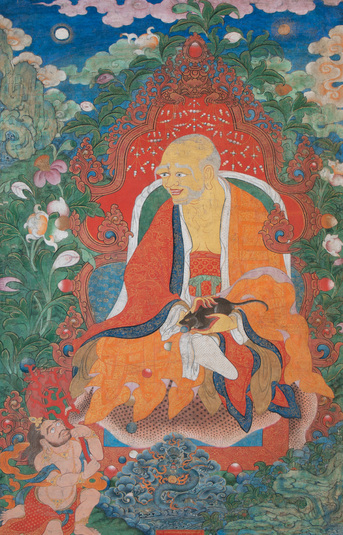
Item: Arhat/Sthavira (Buddhist Elder) - 16 Elders: Bakula
| Origin Location | Tibet |
|---|---|
| Date Range | 1700 - 1799 |
| Lineages | Buddhist |
| Material | Ground Mineral Pigment on Cotton |
| Collection | Private |
Classification: Person
Appearance: Arhat
Gender: Male
Bakula, the Elder (Sanskrit: Sthavira Bakula): the 9th Elder from the set of Sixteen Great Elders, regarded as the principal students to the buddha Shakyamuni. A name inscription at the bottom of the composition identifies the Elder.
"To the noble elder, the great Bakula of Northern Kuru, surrounded by a retinue of 900 arhats; to the feet of all those I bow." (Sakya liturgical text).
According to the Bakula Sutra (sutta) the elder named Bakula is said to have lived as an ascetic, late in age embracing the Buddhist path, after meeting with the Tathagata Shakyamuni. Receiving ordination as a monk, and renowned for having a deep faith, he quickly attained the level of an arhat. It is also stated that he chose to enter nirvana prior to that of the Buddha. This narrative which is based on Pali scripture is therefore different from the later text that describes the cult of the sixteen great elders.
The group of sixteen elders are based on a text possibly dating to the 4th or 5th century C.E. titled the Arya Nanda Mitra Avadana Nama. In this later text an elder named Bakula (Nakula, Vakula) remains on earth promising to watch over humanity until the coming of the next Buddha Maitreya.
The special blessing that he bestows is the basic material needs and requisites for anyone seeking to follow the path of Buddha. The Elder Bakula is most commonly portrayed holding a mongoose, however there are several different and varying iconographic traditions depicting the arhats. The Sixteen Great Arhats are almot always painted as a set. Typically the full group would include the buddha Shakyamuni with the two foremost disciples, the sixteen arhats, the attendant Dharmatala, the patron Hvashang and the Four Guardians of the Directions: Vaishravana, Virupaksha, Dritarashtra and Virudhaka. In total the set would be composed of twenty-three paintings, but twenty-five figures with the two disciples depicted in the same composition as Shakyamuni Buddha.
There is a Tibetan script, but Sanskrit language, name inscription in a red cartouche found at the bottom center of the painting. It reads “Arya Sthavira Bakula Namo!” In translation it states “Homage to the Noble Elder Bakula!” On the reverse of the painting there are two mantras of sanctification to belss the composition: om sarva vidya svaha! om vajra ayushe svaha!
In Western art history we generally refer to this group of Sixteen Great Elders as arhats. In fact they are not arhats but rather sthavira which is a different and lower level of Buddhist hierarchy based on mental attainemnt in meditation. The 19th century use of the Sanskrit word arhat appears to be a simple mistake in translation and understanding on the part of the early Western scholars. It is a mistake that is now very hard to correct since the word ‘arhat’ is found universally in English language Asian Art History.
Jeff Watt 6-2018
Front of Painting
English Translation of Inscription: Homage to the Noble Elder Bakula!
Wylie Transliteration of Inscription: Arya Sthavira Bakula Namo!
Reverse of Painting
Wylie Transliteration of Inscription: Om sarva vidya svaha! Om vajra ayushe svaha!
Collection: Kapoor Galleries
Painting Set: Arhat Set with Gold Fill
Painting Type: Gold Fill Paintings
Subject: Mongoose Symbolism
Collection: Kapoor Galleries (Masterworks)
Arhat/Sthavira: Bakula Masterworks
Collection of Anna Maria Rossi & Fabio Rossi
Arhat/Sthavira: Bakula Main Page
Subject: Elders with Beards



